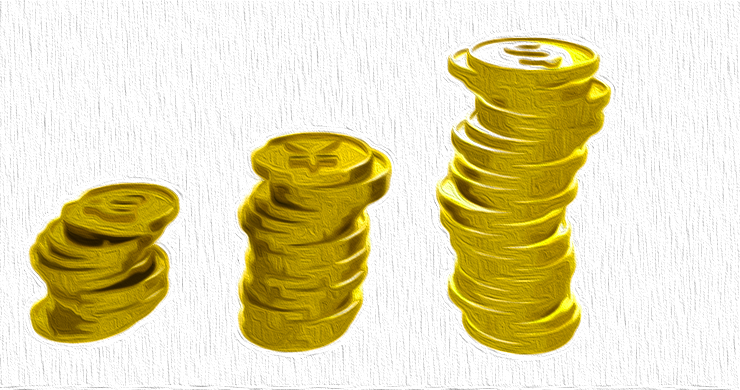
Exploring Bitcoin's Price Trends
Let’s dive into the world of Bitcoin price fluctuations – what a rollercoaster ride it has been! Last week showcased a mix of anticipated dips and unexpected plunges triggered by external market factors. The impact of Trump's trade announcements on China caused a significant market downturn, leading to a frenzy in the crypto realm.
Unveiling Key Support and Resistance Levels
Testing the $105K Support
Despite the turmoil, Bitcoin managed to cling onto the $105,000 support level, offering a temporary shield against further decline. This critical juncture will be closely monitored by bullish investors aiming for price stabilization. However, a breach could potentially signal a downward spiral towards the $96,000 mark, posing a threat to the current bullish momentum.
Fibonacci Retracement Insights
By tracing the price movement from the recent high to the low, the Fibonacci Retracement highlights pivotal resistance levels. Surpassing the 0.618 Fibonacci Retracement at $118,350 could pave the way for a bullish resurgence, with a breakthrough above $121,800 indicating a bullish trend continuation.
Forecast for the Upcoming Week
Charting the Path Ahead
Following the significant rebound post the sell-off, Bitcoin's future trajectory remains uncertain. Oscillators, while leaning bearish, leave room for bullish maneuvers. Monitoring the 0.236 Fibonacci Retracement support at $110,500 will be crucial to prevent a revisit to the $105,000 level.
Bulls vs. Bears Clash
The battle for dominance persists between the $112,000 and $118,350 range, with $115,630 serving as the pivotal point for market sentiment. Bitcoin might linger within this range, awaiting a decisive shift in momentum. The recent bearish sentiment prevails, necessitating strategic moves from the bulls to reclaim control.
Market Sentiment: Riding the Bearish Wave
Post-Dump Reflections
Friday's market plunge left both bulls and bears reeling from the impact. Despite a partial recovery, the bulls face an uphill climb to regain authority over the price action. The current market landscape demands vigilance and calculated maneuvers to navigate the ongoing volatility.
Insights for the Weeks Ahead
Navigating Trend Lines and Price Patterns
Monitoring Bitcoin's movement within the broadening wedge pattern poses challenges and opportunities. While a return to the upper trend line could signal bullish prospects, breaching the lower trend line might trigger a bearish downturn. Maintaining stability above key levels is essential to avoid potential price slumps.
Strategic Considerations for Investors
Investors treading cautiously in the volatile market must remain alert to price fluctuations. Avoiding the $105,000 danger zone and striving for a breakthrough above $122,000 will be pivotal in shaping future investment decisions.
Decoding Crypto Jargon
Demystifying Market Terms
Understanding terms like bulls, bears, support, resistance, Fibonacci retracements, and broadening wedges is crucial for navigating the crypto landscape effectively. By grasping these concepts, investors can make informed decisions and adapt to market dynamics seamlessly.
As the crypto saga unfolds, staying informed and proactive is key to thriving in the ever-evolving market environment. Embrace the challenges, equip yourself with knowledge, and embark on your crypto journey with confidence!
Frequently Asked Questions
Should You Invest Gold in Retirement?
How much money you have saved, and whether or not gold was an option when you first started saving will determine the answer. If you're unsure about which option to choose then consider investing in both.
Gold offers potential returns and is therefore a safe investment. It's a great investment for retirees.
While many investments promise fixed returns, gold is subject to fluctuations. Because of this, gold's value can fluctuate over time.
However, it doesn't necessarily mean that you shouldn't invest your money in gold. It just means that you need to factor in fluctuations to your overall portfolio.
Another advantage of gold is its tangible nature. Gold is much easier to store than bonds and stocks. It can also be carried.
As long as you keep your gold in a secure location, you can always access it. Physical gold is not subject to storage fees.
Investing in gold can help protect against inflation. It's a great way to hedge against rising prices, as gold prices tend to increase along with other commodities.
A portion of your savings can be invested in something that doesn't go down in value. Gold usually rises when the stock market falls.
Another advantage to investing in gold is the ability to sell it whenever you wish. You can also liquidate your gold position at any time you need cash, just like stocks. You don't even need to wait for your retirement.
If you do decide to invest in gold, make sure to diversify your holdings. Don't place all your eggs in the same basket.
Also, don't buy too much at once. Start by purchasing a few ounces. Then add more as needed.
It's not about getting rich fast. Rather, it's to build up enough wealth so you won't need to rely on Social Security benefits.
And while gold might not be the best investment for everyone, it could be a great supplement to any retirement plan.
Can I purchase gold with my self directed IRA?
Although you can buy gold using your self-directed IRA account, you will need to open an account at a brokerage like TD Ameritrade. You can also transfer funds from an existing retirement fund.
The IRS allows individuals to contribute as high as $5,500 ($6,500 if they are married and jointly) to a traditional IRA. Individuals may contribute up to $1,000 ($2,000 if married, filing jointly) directly into a Roth IRA.
If you do decide that you want to invest, it is a good idea to buy physical bullion and not in futures. Futures contracts can be described as financial instruments that are determined by the gold price. You can speculate on future prices, but not own the metal. But, physical bullion is real bars of gold or silver that you can hold in one's hand.
How Do You Make a Withdrawal from a Precious Metal IRA?
You first need to decide if you want to withdraw money from an IRA account. Next, ensure you have enough cash on hand to pay any penalties or fees that could be associated with withdrawing funds.
An IRA is not the best option if you don't mind paying a penalty for early withdrawal. Instead, open a taxable brokerage. If you decide to go with this option, you will need to take into account the taxes due on the amount you withdraw.
Next, you need to determine how much money is going to be taken out from your IRA. This calculation will depend on many factors including your age at the time of withdrawal, how long the account has been in your possession, and whether you plan to continue contributing towards your retirement plan.
Once you know how much of your total savings to convert to cash, it's time to choose the type of IRA that you want. While traditional IRAs are tax-free, Roth IRAs can be withdrawn at any time after you reach 59 1/2. However, Roth IRAs will charge income taxes upfront and allow you to access your earnings later without additional taxes.
Once you have completed these calculations, you need to open your brokerage account. Brokers often offer promotional offers and signup bonuses to encourage people into opening accounts. It is better to open an account with a debit than a creditcard in order to avoid any unnecessary fees.
When you finally get around to making withdrawals from your precious metal IRA, you'll need a safe place where you can store your coins. Some storage facilities will accept bullion bars, others require you to buy individual coins. Before choosing one, consider the pros and disadvantages of each.
Bullion bars are easier to store than individual coins. However, each coin will need to be counted individually. On the flip side, storing individual coins allows you to easily track their value.
Some people prefer to keep their coins in a vault. Some people prefer to store their coins safely in a vault. No matter what method you use, it is important to keep your bullion safe so that you can reap its benefits for many more years.
Who is the owner of the gold in a gold IRA
An individual who has gold is considered to be a “form of money” by the IRS and subject to taxation.
You must have gold at least $10,000 and it must be stored for at the least five years in order to take advantage of this tax-free status.
Although gold can help to prevent inflation and price volatility, it's not sensible to have it if it's not going to be used.
If you plan to eventually sell the gold, you'll need a report on its value. This could impact the amount of capital gains taxes your owe if you cash in your investments.
To find out what options you have, consult an accountant or financial planner.
Statistics
- (Basically, if your GDP grows by 2%, you need miners to dig 2% more gold out of the ground every year to keep prices steady.) (smartasset.com)
- The price of gold jumped 131 percent from late 2007 to September 2011, when it hit a high of $1,921 an ounce, according to the World Gold Council. (aarp.org)
- If you take distributions before hitting 59.5, you'll owe a 10% penalty on the amount withdrawn. (lendedu.com)
- Contribution limits$6,000 (49 and under) $7,000 (50 and up)$6,000 (49 and under) $7,000 (50 and up)$58,000 or 25% of your annual compensation (whichever is smaller) (lendedu.com)
- Indeed, several financial advisers interviewed for this article suggest you invest 5 to 15 percent of your portfolio in gold, just in case. (aarp.org)
External Links
forbes.com
- Gold IRA – Add Sparkle to Your Retirement Nest Egg
- Understanding China's Evergrande Crisis – Forbes Advisor
finance.yahoo.com
law.cornell.edu
- 7 U.S. Code SS7 – Designation Boards of Trade as Contract Markets
- 26 U.S. Code SS 408 – Individual retirement account
cftc.gov
How To
The History of Gold as an Asset
From the beginning of history, gold was a popular currency. It was universally accepted and loved for its beauty, durability, purity and divisibility. It was also traded internationally due to its high value. However, since there were no international standards for measuring gold at this point, different weights and measures existed worldwide. For example in England, a pound sterling equals 24 carats. In France, a livre tournois equals 25. Carats of golden. Germany had one mark which equals 28. Carats.
In the 1860s, the United States began to issue American coins made from 90% copper, 10% Zinc, and 0.942 Fine Gold. This led to a decrease of demand for foreign currencies which in turn caused their prices to rise. In this period, large amounts of gold coin were minted by the United States, which caused the gold price to drop. Due to the excessive amount of money flowing into the United States, they had to find a way for them to repay some of their debt. To do so, they decided to sell some of the excess gold back to Europe.
Many European countries began accepting gold in exchange for the dollar because they did not trust it. However, many European nations stopped using gold to pay after World War I and started using paper currency instead. The price of gold has risen significantly since then. Even though gold's price fluctuates, it is still one of the most secure investments you could make.
—————————————————————————————————————————————————————————————–
By: Ethan Greene – Feral Analysis
Title: Bitcoin Price Analysis: Weekly Close at $115K Following Friday’s Volatility
Sourced From: bitcoinmagazine.com/markets/bitcoin-weekly-close-at-115k-after-fridays-crash-support-at-105k-holds-but-bears-dominate
Published Date: Mon, 13 Oct 2025 18:32:08 +0000
















